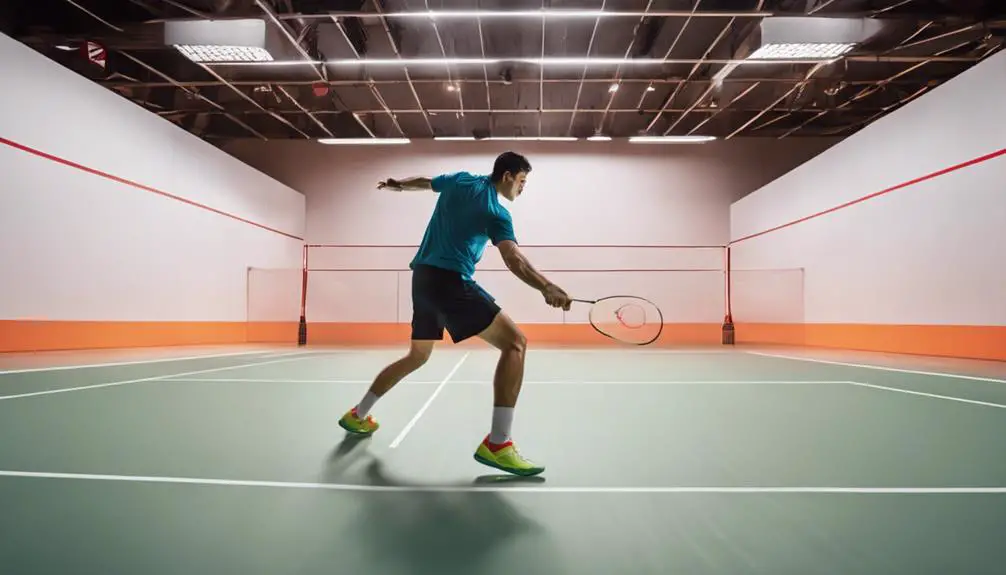When you compare squash and badminton, you’ll find they create very different playing experiences. Squash takes place in an enclosed court, demanding quick reflexes and strategic positioning, while badminton emphasizes agility and aerial dynamics in an open space. The scoring systems vary, with squash commonly using point-a-rally and badminton often played to 21 points. Equipment differs too; squash utilizes heavier balls, whereas badminton features lightweight rackets and shuttlecocks. Both sports promote cardiovascular fitness and coordination, but they cater to distinct preferences and fitness goals. If you’re curious about which sport might suit you better, you might want to explore further.
Overview of Squash

When you step onto a squash court, you’re entering a fast-paced world where strategy and agility reign supreme. The dimensions of a standard squash court are 32 feet long and 21 feet wide, creating a dynamic environment for players to showcase their skills. The enclosed space demands quick reflexes and sharp tactical thinking, as the ball can rebound off walls in unpredictable ways.
Equipment variations can also influence your gameplay. You’ll find a range of squash rackets, each designed to enhance different aspects of your game—from control to power. The choice of ball is equally essential; different balls have varying bounciness, affecting pace and strategy. A softer ball, for instance, requires players to maintain longer rallies, while a harder ball can lead to quicker points.
Gameplay strategies in squash revolve around positioning, shot selection, and anticipating your opponent’s moves. You’ll need to master the art of volleying, taking the initiative to control the pace of the game. Additionally, effective court coverage is critical; being able to read the game enhances your chances of winning.
The scoring systems in squash can vary. Traditional games often use a hand-in-hand-out scoring method, while modern formats typically employ point-a-rally systems, where every rally counts towards your score. Understanding these rules can greatly impact your approach, as they influence both offensive and defensive strategies. Embracing these elements will elevate your squash experience and give you the freedom to express your unique playing style.
Overview of Badminton
How does badminton captivate players with its blend of speed and finesse? This dynamic sport, steeped in badminton history, offers an exhilarating experience that calls for quick reflexes and strategic thinking. Originating from the game of battledore and shuttlecock in 5th century BC, badminton evolved into a popular competitive sport in the 19th century, gaining widespread recognition across the globe.
When you step onto the court, the right badminton equipment can make all the difference. A lightweight racket, typically made from materials like carbon fiber or aluminum, allows for swift maneuverability. The shuttlecock, either feathered or synthetic, plays a pivotal role in the game, dictating the speed and style of play. Each piece of equipment is designed to enhance your performance and adaptability, allowing for a personalized playing style.
As you engage in a match, you’ll appreciate the sport’s emphasis on agility and precision. Every rally showcases your ability to react instantly, positioning yourself for that perfect shot. The diverse range of playing styles—from aggressive smashes to delicate drop shots—ensures that badminton remains an exciting challenge, regardless of your skill level.
Ultimately, badminton invites you to embrace a lifestyle of freedom, where each game is a reflection of your dedication and skill. It’s not just a sport; it’s a celebration of movement, strategy, and the joy of competition, waiting for you to plunge into and experience it for yourself.
Key Differences Between Sports

Squash and badminton, though both racquet sports, exhibit distinct characteristics that set them apart in gameplay, strategy, and overall experience. One of the most noticeable differences lies in court dimensions. A squash court is enclosed, measuring 32 feet long and 21 feet wide, which creates a dynamic environment where walls come into play. In contrast, badminton courts are open, measuring 44 feet long and 20 feet wide for doubles, leading to a different style of play that emphasizes aerial dynamics.
When it comes to scoring systems, squash often employs a point-a-rally system, where every rally counts for a point, regardless of who serves. Badminton also uses a rally scoring system, but matches are typically played to 21 points, requiring a player to win by two. This affects how players strategize their gameplay and manage their energy throughout the match.
Equipment differences further enhance the uniqueness of each sport. Squash players use a smaller, heavier ball and a racquet with a shorter handle, designed for quick strikes and control. Badminton players wield lightweight racquets and a shuttlecock, which requires precision and finesse, as the shuttle’s flight can be heavily influenced by wind conditions.
Lastly, player movement varies substantially. In squash, you’ll often find yourself quickly shifting and pivoting in tight spaces, relying on agility. In badminton, the focus is on lateral movement and explosive jumps, which demands different physical skills. These key differences shape not just how you play, but how you experience each sport.
Health Benefits of Each Sport
Both squash and badminton not only entertain but also offer a range of health benefits that can enhance your overall well-being. When you engage in either sport, you’re working on your cardiovascular fitness. Squash, with its fast-paced movements and quick sprints, challenges your heart and lungs, while badminton promotes aerobic capacity through continuous play and dynamic movement.
Muscular endurance is another advantage you gain from both activities. Squash players develop strong leg and core muscles due to the constant lunging and pivoting, while badminton players build upper body strength through powerful overhead strokes. This combination helps maintain muscle tone and functional strength, which is crucial for everyday activities.
Both sports also provide excellent stress relief. The physical exertion releases endorphins, helping you combat anxiety and improve your mood. Plus, the social interaction involved—whether you’re playing doubles in badminton or joining a squash league—creates a sense of community and belonging, which is essential for mental health.
Improving coordination skills is another benefit you can expect. The rapid reactions required in squash and the precise movements in badminton sharpen your reflexes and hand-eye coordination. Additionally, both sports encourage injury prevention through proper warm-ups and conditioning, making your body more resilient.
Choosing the Right Sport for You

Deciding on the right sport for you involves weighing your personal preferences, fitness goals, and lifestyle. Both squash and badminton offer unique experiences, but aligning your choice with what resonates with you is essential. Here’s a quick breakdown to help you decide:
- Personal Preferences: Think about what excites you. Do you thrive in high-energy environments, or do you prefer a strategic, fast-paced setting? Squash demands quick reflexes and an aggressive stance, while badminton often combines finesse with agility.
- Skill Levels: Assess your current skill level. If you’re a beginner, badminton might be more forgiving, allowing you to enjoy the game without feeling overwhelmed. On the other hand, if you’re looking for a challenge, squash can sharpen your skills quickly with its continuous play.
- Fitness Goals: Consider what you want to achieve. If you’re aiming for intense cardio workouts, squash might be your best bet, as it involves rapid movement and endurance. However, if you’re looking for a sport that enhances flexibility and coordination, badminton could be more suitable.
Ultimately, the right sport for you aligns with your personal preferences, complements your skill levels, and supports your fitness goals. Take the time to explore both sports, and don’t be afraid to experiment. After all, the freedom to choose is what makes your athletic journey uniquely yours.
Frequently Asked Questions
What Are the Historical Origins of Squash and Badminton?
The historical origins of both games reveal fascinating game evolution and cultural significance. By exploring their roots, you’ll discover how they adapted to societal changes, reflecting the values and interests of their respective communities throughout time.
How Are the Scoring Systems Different in Both Sports?
When you immerse yourself in the scoring systems, you’ll find distinct game formats and scoring strategies. One sport’s rally scoring guarantees every point counts, while the other’s traditional system grants more control over the game’s flow.
What Equipment Is Essential for Beginners in Each Sport?
For beginners, essential equipment includes the right racket types suited to each sport and understanding court dimensions. A proper racket enhances your game, while knowing court size helps you navigate effectively and play freely.
Can Squash and Badminton Be Played Indoors or Outdoors?
Both sports can be enjoyed indoors, offering benefits like controlled environments and consistent conditions. However, outdoor play presents challenges such as weather variability and space constraints, making indoor facilities often the preferred choice for enthusiasts.
What Are Common Injuries Associated With Squash and Badminton?
When playing racquet sports, you might encounter common injuries like ankle sprains and shoulder injuries. These can arise from quick movements and repetitive motions, so it’s essential to warm up and use proper techniques to minimize risks.




